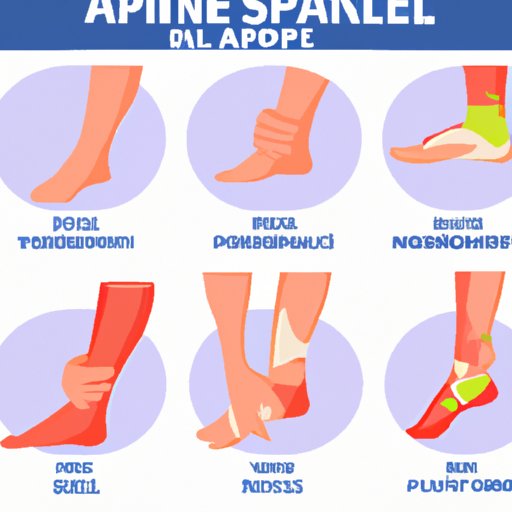
I. Introduction
Ankle sprains are a common injury that can happen to anyone at any time, whether you’re an athlete, a weekend warrior, or simply walking down the street. While ankle sprains are rarely life-threatening, they can be incredibly painful and disruptive to your daily life. Recognizing and treating an ankle sprain early can help prevent long-term damage and reduce recovery time. In this article, we will take a detailed look at everything you need to know about ankle sprains, including how to recognize symptoms, causes, treatment, and prevention.
II. Symptoms of an ankle sprain
One of the first steps in recognizing an ankle sprain is knowing its symptoms. The most common symptoms of an ankle sprain are:
- Pain or soreness
- Swelling
- Bruising
- Difficulty walking or standing
- Stiffness or limited range of motion
Mild ankle sprains generally have less pain and swelling than severe sprains. It’s important to remember that even mild ankle sprains can become serious if left untreated.
III. Causes of ankle sprains
Understanding how the foot and ankle are built is essential to understanding how ankle sprains happen. The ankle joint is a complex structure made up of bones, muscles, tendons, and ligaments. When the ankle joint is forced beyond its normal range of motion, the ligaments that connect the bones can become stretched or torn, leading to a sprained ankle. Some common activities that can lead to ankle sprains include:
- Running or jogging on uneven surfaces
- Landing awkwardly after a jump
- Sudden changes in direction while moving
- Twisting or rolling your ankle
IV. The types of ankle sprains
The ankle joint has three ligaments, which can be affected by a sprain. These are:
- The anterior talofibular ligament
- The posterior talofibular ligament
- The calcaneofibular ligament
The type of sprain you have depends on which ligament is affected. Generally, sprains can be categorized into three classes:
- Grade 1: The ligament is stretched but not torn. There is minimal pain and swelling, and the joint is still stable.
- Grade 2: The ligament is partially torn. There will be moderate pain and swelling, and the joint may feel unstable.
- Grade 3: The ligament is completely torn. There will be severe pain and swelling, and the joint will feel very unstable.
The recovery time for an ankle sprain will depend on its severity. Mild sprains may only require a few days of rest and at-home care, while more severe sprains may require weeks or even months of medical treatment.
V. At-home remedies for ankle sprains
The most commonly recommended at-home treatment for ankle sprains is the RICE method:
- Rest: Avoid any activities that cause pain or discomfort.
- Ice: Apply ice to the affected area for 20 minutes at a time, 3-4 times a day.
- Compression: Wrap the affected area in a compression bandage to reduce swelling.
- Elevation: Keep the affected area elevated to reduce swelling.
In addition to the RICE method, there are some gentle exercises that you can do to relieve pain and swelling. These exercises include:
- Ankle pumps
- Ankle rotations
- Toe raises
You can also try over-the-counter pain medications, such as ibuprofen or acetaminophen, to manage pain. If your pain is severe, your doctor may prescribe stronger pain medication.
VI. Medical treatment for ankle sprains
If your ankle sprain is severe or doesn’t respond to at-home treatments, you may need medical treatment. Depending on the severity of your injury, you may see a primary care physician, a podiatrist, or an orthopedic specialist. Your doctor may order tests or imaging, such as an X-ray or an MRI, to determine the extent of the injury. The most common medical treatments for ankle sprains include:
- Physical therapy to help regain strength and range of motion in your ankle
- A brace or cast to immobilize your ankle while it heals
- Anti-inflammatory medications to manage pain and swelling
- Surgery, in severe cases that do not respond to other treatments
VII. Preventing ankle sprains
Preventing ankle sprains is key to avoiding long-term damage. Some simple steps you can take to prevent ankle sprains include:
- Wearing appropriate shoes for the activity you are doing
- Warming up before exercise
- Practicing balance exercises
- Maintaining healthy weight to avoid excess stress on the joints
VIII. Conclusion
Ankle sprains are a common injury that can happen to anyone. Recognizing the symptoms, causes, treatment, and prevention of ankle sprains is essential to avoiding long-term damage and reducing recovery time. Whether you’re dealing with a mild sprain or a more severe injury, it’s important to work with a doctor to ensure the best possible outcome. By taking preventive measures, you can help reduce your risk of ankle sprains in the future, and keep your joints healthy and strong.





